Richmond, VA Pollen and Allergy Report for Summer 2023
Pollen Allergy Trends in Richmond, VA
When is pollen lowest in Richmond, VA?

February
Lowest month total PPM
Avg. PPM
When is pollen highest in Richmond, VA?

April
Highest month total PPM
Avg. PPM
How does pollen in Richmond, VA compare to Virginia?
Richmond has a lower average PPM than the state of Virginia.
Richmond yearly avg PPM:
Virginia yearly avg PPM:
How does pollen in Richmond, VA compare to the USA?
Richmond has a higher average PPM than the USA.
Richmond yearly avg PPM:
USA yearly avg PPM:
Is pollen worse this year in Richmond, VA?
Spring 2023 was worse than spring 2022.
Spring 2023 PPM:
Spring 2022 PPM:
Average PPM in Richmond, VA


Richmond, VA Pollen and Allergy Breakdown by Month
Grass
When is grass pollen highest in Richmond, VA?
April has the highest grass pollen in Richmond, VA with an average PPM of
When is grass pollen lowest in Richmond, VA?
December has the lowest grass pollen in Richmond, VA with an average PPM of
Tree
When is tree pollen highest in Richmond, VA?
April has the highest tree pollen in Richmond, VA with an average PPM of
When is tree pollen lowest in Richmond, VA?
October has the lowest tree pollen in Richmond, VA with an average PPM of
Weed
When is weed pollen highest in Richmond, VA?
April has the highest weed pollen in Richmond, VA with an average PPM of
When is weed pollen lowest in Richmond, VA?
February has the lowest weed pollen in Richmond, VA with an average PPM of
Richmond, VA Pollen Monthly Breakdown by Pollen Type




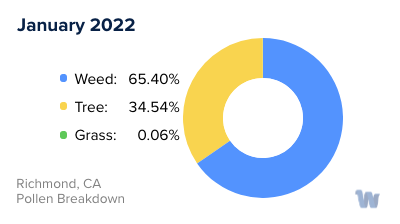
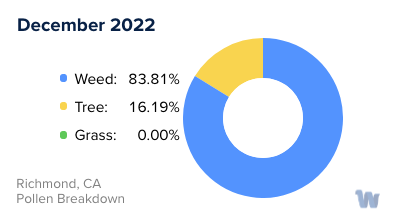


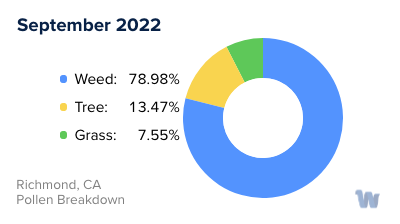
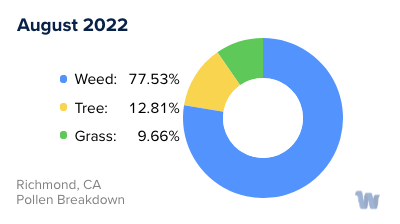

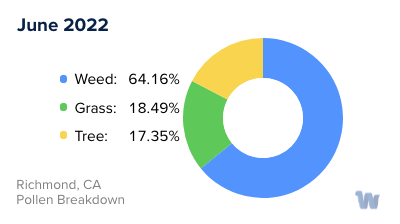
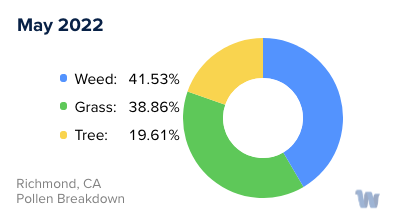

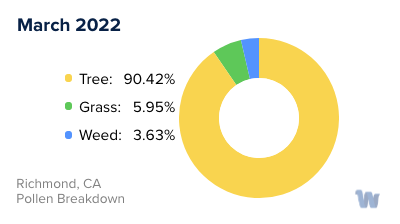

Pollen and Hay Fever in Richmond, VA
Pollen allergies, often referred to as hay fever, are a common concern for many residents of Richmond, Virginia. These allergies are triggered by the inhalation of pollen, tiny powdery granules released by plants for the purpose of fertilization.
In Richmond, the primary sources of pollen are trees, grasses, and weeds, each of which has its unique pollinating season. The city's diverse flora contributes to a lengthy pollen season, spanning from early spring to late fall, making it a hotspot for pollen allergies.
The onset of spring in Richmond welcomes a flurry of tree pollen. Oaks, pines, and maples are prolific pollinators, and their pollen grains can travel great distances on the wind. The density of these trees in Richmond's parks and neighborhoods means that tree pollen is prevalent from March through June, making spring a challenging time for allergy sufferers.
As spring transitions into summer, grasses begin to release their pollen. Common grasses in Richmond, such as Bermuda grass, Timothy grass, and Kentucky bluegrass, typically pollinate from May to July. The fine, lightweight pollen these grasses produce can also be easily carried by the wind, contributing to the overall pollen count in the atmosphere.
In late summer and early fall, weed pollen comes into play. Ragweed is a particular concern in Richmond, with its pollination period stretching from August to November. Each ragweed plant can produce up to a billion pollen grains in a season, significantly increasing the pollen load in the air.
In conclusion, Richmond's diverse plant life contributes to a substantial pollen season, with tree, grass, and weed pollens successively dominating the air from early spring to late fall. Understanding the types of pollen and their respective seasons can help Richmond residents anticipate and prepare for the challenges of pollen allergies.


